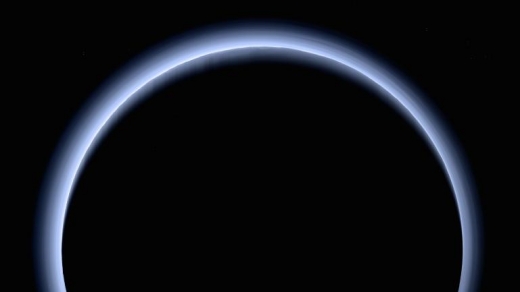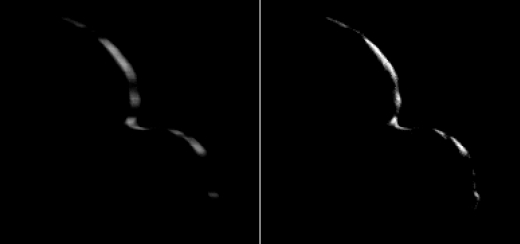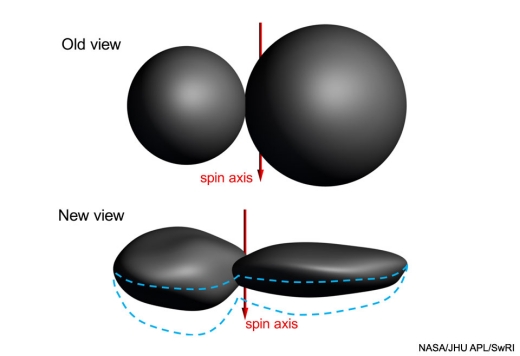Sometimes the way we discover new things is by looking back, as witness the blue haze of Pluto. The image below comes, of course, from New Horizons, taken after the flyby and looking back in the direction of the Sun. Here we’re looking at a mosaic combining black and white LORRI images (Long Range Reconnaissance Imager) and enhancing them with lower-resolution color data from the Ralph/Multispectral Visible Imaging Camera (MVIC). The result, taken about 3.5 hours after closest approach, is in approximately true color.

Image: Pluto as seen by New Horizons from 200,000 kilometers after the flyby. The spectacular blue haze, extending to over 200 kilometers in altitude, is the result of sunlight acting on methane and other molecules in Pluto’s atmosphere to produce a photochemical haze. Credit: NASA/Johns Hopkins University Applied Physics Laboratory/Southwest Research Institute.
Ultima Thule likewise yields more of its secrets as we look at data from beyond the closest encounter. New Horizons’ latest target produced departure imagery fleshing out our view of the object’s shape by showing us parts of the KBO that were not illuminated by the Sun during the approach. We learn that the two lobes of Ultima Thule are not spherical at all, but rather that the larger lobe is flattened into a pancake shape, while the New Horizons team sees in the smaller lobe a resemblance to a dented walnut. Here is a video rendering of the data.
Image: Mission scientists created this “departure movie” from 14 different images taken by the New Horizons Long Range Reconnaissance Imager (LORRI) shortly after the spacecraft flew past the Kuiper Belt object nicknamed Ultima Thule (officially named 2014 MU69) on Jan. 1, 2019. The central frame of this sequence was taken on Jan. 1 at 05:42:42 UT (12:42 a.m. EST), when New Horizons was 8,862 kilometers (5,494 miles) beyond Ultima Thule, some 6.6 billion kilometers (4.1 billion miles) from Earth. The object’s illuminated crescent is blurred in the individual frames because a relatively long exposure time was used during this rapid scan to boost the camera’s signal level – but the science team combined and processed the images to remove the blurring and sharpen the thin crescent. This is the farthest movie of any object in our Solar System ever made by any spacecraft. Credit: NASA/Johns Hopkins Applied Physics Laboratory/Southwest Research Institute/National Optical Astronomy Observatory.
“We’ve never seen something like this orbiting the Sun,” says mission PI Alan Stern, adding:
“We had an impression of Ultima Thule based on the limited number of images returned in the days around the flyby, but seeing more data has significantly changed our view. It would be closer to reality to say Ultima Thule’s shape is flatter, like a pancake. But more importantly, the new images are creating scientific puzzles about how such an object could even be formed.”

Image: New Horizons took this image of Ultima Thule on Jan. 1, 2019, when the NASA spacecraft was 8,862 kilometers (5,494 miles) beyond it. The image to the left is an “average” of ten images taken by the Long Range Reconnaissance Imager (LORRI); the sharper processed view is to the right. Credit: NASA/Johns Hopkins Applied Physics Laboratory/Southwest Research Institute/National Optical Astronomy Observatory.
Observing stars as they disappeared when Ultima Thule passed in front of them allowed scientists to further refine the shape. The illustration below shows the evolution of our understanding, as we’ve moved from the ‘snowman’ to the ‘pancake’ model.
“While the very nature of a fast flyby in some ways limits how well we can determine the true shape of Ultima Thule, the new results clearly show that Ultima and Thule are much flatter than originally believed, and much flatter than expected,” adds Hal Weaver, New Horizons project scientist from the Johns Hopkins Applied Physics Laboratory. “This will undoubtedly motivate new theories of planetesimal formation in the early solar system.”

Image: Scientists’ understanding of Ultima Thule has changed as they review additional data. The “old view” in this illustration is based on images taken within a day of New Horizons’ closest approach to the Kuiper Belt object on Jan. 1, 2019, suggesting that both “Ultima” (the larger section, or lobe) and “Thule” (the smaller) were nearly perfect spheres just barely touching each other. But as more data were analyzed, including several highly evocative crescent images taken nearly 10 minutes after closest approach, a “new view” of the object’s shape emerged. Ultima more closely resembles a “pancake,” and Thule a “dented walnut.” The bottom view is the team’s current best shape model for Ultima Thule, but still carries some uncertainty as an entire region was essentially hidden from view, and not illuminated by the Sun, during the New Horizons flyby. The dashed blue lines span the uncertainty in that hemisphere, which shows that Ultima Thule could be either flatter than, or not as flat as, depicted in this figure. Credit: NASA/Johns Hopkins University Applied Physics Laboratory/Southwest Research Institute.



“We’ve never seen something like this …”
THAT is the continuing draw of “the final frontier.” Gotta love it. Long live space exploration!
It does seem remarkable that the two highest profile small astronomical bodies in news cycles over the past couple of years—‘Oumuamua and now Ultima Thule—should prove to have such unlikely shapes. Surely, at the very least, this should raise questions about (a) how such bodies get to be formed and (b) how common these “unlikely”-proportioned bodies actually are?
Even with this new data, I find it hard to believe the proposed shape. Surprised me. Even looking at the older images, they seem to fool my eye into extrapolating a more spherical shape.
This image seems to show a few crater impacts on the major lobe’s terminator. I also wonder if the bright spots are fresh ices exposed from impacts, or possibly even analogous to those on Ceres.
If the shape is unusual, then the team lucked out on selecting this target. Or just maybe it isn’t unusual.
We should not be surprised by the shape of Ultima Thule’s two lobes. I would have been very surprised (as I was at first) to find that they were spherical. Neither is massive enough to self gravitate sufficiently to settle to a spherical shape. This should be obvious since when two of them coalesce, as seen here, and thus increasing the total mass, the lobes still do not collapse to form a single body.
So one of the main questions is how does a pancake shaped object arise? I guess this might be passing the buck a bit but what about an object that was originally much more spherical but with a pancake shaped core, surrounded by rubble which has been removed by ages of collisions with small bodies?
Some pancake-like objects: https://apod.nasa.gov/apod/ap170706.html
And could the pancake shaped object have been sheared off of a larger layered object by a fast moving smaller object such that our object sheared along one of the layers?
Rotation must be the key factor explaining the shapes. Before the parts coalesced into one the pancake-like Ultima must have had a faster rotation rate than walnut-like Thule. They would have been orbiting around each other in the same plane as their equators. (That’s my story, at least until a better one comes along ;)
We’ll probably find that this shape isn’t that uncommon for Kuiper belt objects of similar mass, due to probability.
Looking at this image, it almost looks like on the top of the large lobe that a smaller asteroid became embedded in the large lobe of ice cream. :-/
https://www.sciencealert.com/images/2019-02/processed/UltimaThulenew_web_1024.jpg
Or, maybe the craters were created from large rocks falling off one lobe and impacting on the other lobe as it rotated. :-\
So what type of ice cream is the same color as Ultima Thule?
https://apod.nasa.gov/apod/ap190214.html
2019 February 14
Solar System Family Portait
Image Credit: Voyager Project, NASA
Explanation: On Valentine’s Day in 1990, cruising four billion miles from the Sun, the Voyager 1 spacecraft looked back one last time to make this first ever Solar System family portrait.
The complete portrait is a 60 frame mosaic made from a vantage point 32 degrees above the ecliptic plane. In it, Voyager’s wide angle camera frames sweep through the inner Solar System at the left, linking up with gas giant Neptune, the Solar System’s outermost planet, at the far right.
Positions for Venus, Earth, Jupiter, Saturn, Uranus, and Neptune are indicated by letters, while the Sun is the bright spot near the center of the circle of frames. The inset frames for each of the planets are from Voyager’s narrow field camera.
Unseen in the portrait are Mercury, too close to the Sun to be detected, and Mars, unfortunately hidden by sunlight scattered in the camera’s optical system. Closer to the Sun than Neptune at the time, small, faint Pluto’s position was not covered.
Maybe we’ll also find a giant waffle iron shaped object out there somewhere. It’s food for thought anyway :).
Speaking of looking back….
http://www.planetary.org/explore/space-topics/space-missions/mer-updates/2019/02-mer-update-opportunity-complete.html
Feb 14, 2019, 02:00 am
The Pale Blue Dot Celebrates Its 29th Anniversary, Reminding Us How Small And Fragile We Are
https://www.forbes.com/sites/startswithabang/2019/02/14/the-pale-blue-dot-celebrates-its-29th-anniversary-reminding-us-how-small-and-fragile-we-are/#656c66b577f6
And looking ahead…
“It is in our nature to explore, to reach out into the unknown. The only true failure would be not to explore at all.” — Sir Ernest Shackleton
https://en.wikipedia.org/wiki/Ernest_Shackleton
“Men Wanted for Dangerous Expedition: Low Wages for Long Hours of Arduous Labour under Brutal Conditions; Months of Continual Darkness and Extreme Cold; Great Risk to Life and Limb from Disease, Accidents and Other Hazards; Small Chance of Fame in Case of Success.” – Ernest Shackleton